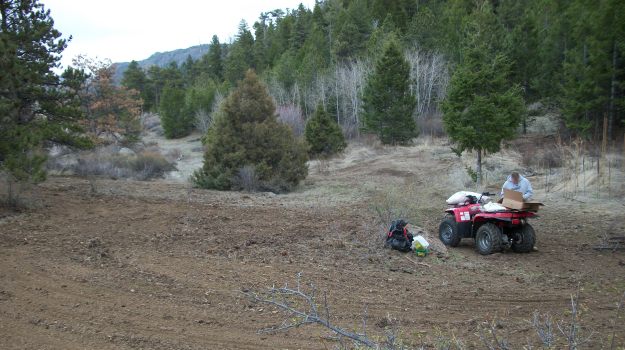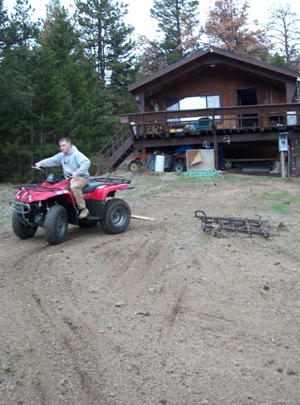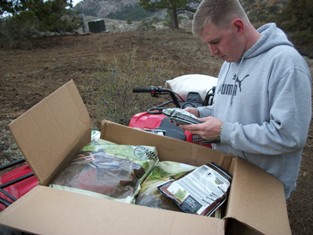
Food plots in arid places
By S. L. Merriam
Planting food plots for mule deer in the Rocky Mountains of Colorado, who would have thought the “Rockies” were a good place for such a plan? Apparently no one except me! I found that out while doing research to plant one such plot. I also learned that the details on Rocky Mountain food plots was about as limited as the details on plant species mule deer require and what they prefer in a food plot in a highly acidic, pine tree habitat.
I have enjoyed taking on this challenge and growing food plots where annual moisture level tops out at a whopping 15-inches per year. I had learned a lot from previous plantings in north western Nebraska and the northern panhandle of Texas. A few of the neighbors mutter under their breath that I am a glutton for punishment, or at least that is what I heard when they spoke loud enough to understand them. But improving a piece of property is the reward.
The location I selected was just south of the Wyoming border below Laramie, near Red Feather, Virginia Dale, and Livermore. I list all three because you can probably only find one of the three on a map. The area had a very high mule deer population about 10 years ago but that changed when the Colorado Division of Wildlife (DOW) used it as a buffer zone for CWD disease migration. The area to the east was mostly private land making it difficult for DOW to get access from the landowners. West of the area lies miles and miles of mule deer habitat that was fully stocked with an assortment of old mossy horned bucks and lies mostly in public land ownership that DOW could access.
This became the targeted area to reduce the deer population hoping that by the time the population built back up the CWD prions in the soil would have died out. Two years and 2,500 dead deer later they reached their goal. In areas where we once saw 40 deer you would now see four, if you were lucky.
I accepted this challenge because I couldn’t change what DOW had done. With a reduced population my plots would get a good start; mule deer can pose a problem when they consume plantings before they ripen or develop sufficient root growth to go deep enough for water during the dry months.
 Since timing would be very important in this venture, a plan would be important. The planting area was roughly 100 by 200-yards with existing natural grass and weeds from lying fallow the last ten years. I selected a valley running east - west with a shaded north slope and a dry south slope. The pH tested from 7.5 8.0. The south slope was made up of decomposed coarse granite with extremely good drainage and the valley bottom was in heavy grass with similar cover on the shaded north side.
Since timing would be very important in this venture, a plan would be important. The planting area was roughly 100 by 200-yards with existing natural grass and weeds from lying fallow the last ten years. I selected a valley running east - west with a shaded north slope and a dry south slope. The pH tested from 7.5 8.0. The south slope was made up of decomposed coarse granite with extremely good drainage and the valley bottom was in heavy grass with similar cover on the shaded north side.
Cultivation would be accomplished with a harrow pulled behind a 4-wheeler breaking up the ground and leveling it for drainage control. We realized that might spread existing rhizomes or native seeds that had yet to germinate, but hoped the new seedlings would germinate fast for a good start. This was something we couldn’t do the following year if we sprayed herbicides now. It was noted that the native grasses would probably catch up with a planting over time and would consume some of the available water.
All of the ground would be prepared but only the food plot for deer attraction would be planted now. The goal was to get the deer comfortable in the area, using trail cameras along with good old-fashion tracks to fill in population blanks.
During the late summer a hunting food plot using blended cereal grains would be planted to provide fast growing green forage when the rest of the mule deer’s world had turned brown and dry. The timing of the hunting plot was determined by using weather statistics from the National Weather service and data from local airport weather history. This was matched to the length of time necessary for the planting to reach peak green growth so it will coincide with the hunting season dates in September, October, and November. A “blend” of fast growing plants would be used over single cultivars so we would have good odds that at least one species would be doing well on opening day and the others would be good into elk season.
The mule deer were curious about the activity in May and would come within 50-yards to watch us work. Variety is a key to their diet just as it is for a whitetail. At that time we were planting plum bushes to provide a unique browse in the area. I suppose consuming the same diet all the time gets old for any animal and mule deer are open to trying something new. I found that out the hard way when we planted five, 12-inch oak trees then came back to find all of them neatly eaten off at ground level.
After June 1st the deer seemed to disappear when the does were busy delivering fawns well away from the activity. The lack of attendance helped me avoid the problem of them eating the new growth too soon. I hoped the deer would come to the food plot as it matured making a smooth transition to the hunting plot when it became lush.
Throughout the summer the spring plot, which we’ll cover in more detail in another article, provided green growth that attracted deer but their wild favorites diverted their attention somewhat and the planting was not over used. A herd of 20 deer with three bucks remained in the area, usually within 500-yards of the plot. A moose also adopted the area, not eating much, but realizing the lush crop was available at any time.
 On the date determined by looking at weather data we ran the harrow over the hunting plot to remove any new weeds and water consuming grasses. I had added six truckloads of ground up tree limbs, courtesy of a local tree trimmer, as organic material. Spreading organics on the soil would lower the pH and add much-needed mulch to the decomposed granite soil. (This is NOT something that a whitetail manager should do east of the Mississippi in acidic soil. Remember that we are on the alkaline side of neutral.) I spread it heavier towards the top of the hill and thinner towards the bottom knowing that gravity and rainwater would bring some of it downhill anyway. This provided the well-drained decomposed granite material to hold precious moisture. I also sprayed a light application of vitamin B to help the roots to get a good hold and a weak nitrogen addition to assist in the poor soil. I was counting on historical moisture levels to arrive and hoped the mulch would hold it to germinate the hunting plot seeding.
On the date determined by looking at weather data we ran the harrow over the hunting plot to remove any new weeds and water consuming grasses. I had added six truckloads of ground up tree limbs, courtesy of a local tree trimmer, as organic material. Spreading organics on the soil would lower the pH and add much-needed mulch to the decomposed granite soil. (This is NOT something that a whitetail manager should do east of the Mississippi in acidic soil. Remember that we are on the alkaline side of neutral.) I spread it heavier towards the top of the hill and thinner towards the bottom knowing that gravity and rainwater would bring some of it downhill anyway. This provided the well-drained decomposed granite material to hold precious moisture. I also sprayed a light application of vitamin B to help the roots to get a good hold and a weak nitrogen addition to assist in the poor soil. I was counting on historical moisture levels to arrive and hoped the mulch would hold it to germinate the hunting plot seeding.
After being left fallow all summer, the hunting plot received a broadcast mixture of winter wheat, oats, barley, rye, triticale, (Wheat/Rye dry land Hybrid) and yellow sweet clover followed by a light pass with the harrow since cereal grains need less than a quarter inch of soil cover. Most of these grains produce quick 15 to 20% protein forage and are about 80 to 92% digestible while being able to tolerate cold and snow for a while. Digestibility is important; digestion requires deer energy and the better the digestibility the less body energy is consumed. With correct timing we had the “magnet factor;” the plot was the only green for miles around this time of the year so once the deer found the food they wouldn’t move far until it was gone or snow covered it.
During the previous winter I had taken photographs of the area to identify the snow-covered areas and the places where the sun exposed bare ground. Since Colorado is blessed with over 300-days of sunshine per year, the radiant heat melts the snow on south facing areas when the temperatures aren’t too low. From these pictures I knew where to sow the seed mixture so green plants would be available during the winter when the sun exposed the soil in select areas. It is quite common to see new growth appear after a stretch of sunny days.
Looking at the results of the seed mixture chosen I’ll start with the winter wheat, which can produce green growth in the fall and, as long as it freezes once during the winter, produces grain before it dies. The deer can eat the foliage to the ground and it will still grow a single shaft in early spring while other plants are either dead or dormant. If the plant didn’t freeze, or the single shaft was eaten off, it would still provide green growth with a good root system all summer. Then the next spring it would come back again. This is breaking one of the rules of a cereal grains when it becomes a biannual instead of an annual, but it lasts only as long as it takes to produce a grain head the first time. When it does head out, the seed grain is easily knocked to the ground during late summer and the cycle begins again. Our first year didn’t have all the right conditions for winter wheat, lacking the cold temperature, but with the added compost layer to help the high pH we had a fine crop of winter or as some call it, “red wheat.”
Rye is a rugged plant, which provides food as a young shoot, but the deer will pass on it once it matures. Triticale usually grows a short stalk then a grain head. Many times it will replant itself with dropped, ripe seed because of the short growing time required. It is more desirable as it grows green but when it matures the seed will sprout and grow green in the spring. It was designed as a dry land wheat equivalent and does well on minimal moisture. As you can see I preach blending seeds in all plots for many reasons. The blended seed crop plants will never ripen at the same time and not every seed choice will do well.
Blended seed plots will never look like a freshly mowed lawn and if that is what you want, then your choice is Kentucky Blue Grass and hope the right weather and soil conditions last all season. The diversity of using multiple grains in a blend like Outfitter’s Blend cannot be over emphasized in an area where you can’t control water, rainfall, sunlight, or temperature.
My friends always tell me deer won’t eat just grass, they need a diversified browse diet. My simple answer is this: green growth is like candy to them during specific periods. We enjoy salad as well as meat, but we need both. Deer can easily find the bushes with buds and small twigs they need that make their first stomach’s enzymes work properly for digestion. Mule deer in late winter and early spring rely heavily on the buds of natural bitterbrush and mountain mahogany for the 15% protein and 50% digestibility. In our area I found them eating natural foods but they repeatedly came back and checked for new growth in the plot area as a part of their normal routine. Don’t worry about their digestion. Deer will provide the proper balance, but when you make “green candy” available, they will make it a point to check the candy dish before looking for dinner.






























